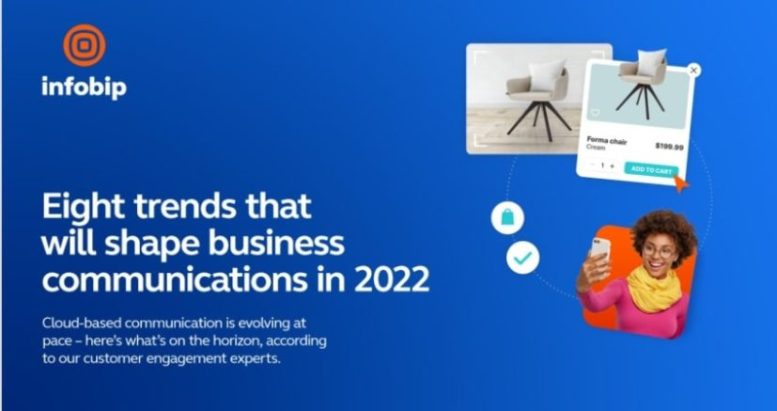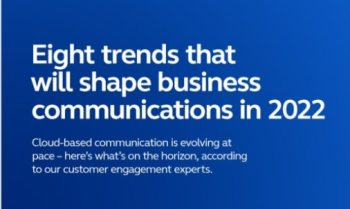Infobip The communications trends that will shape 2022
James Stokes, Enterprise Team Lead UK & Ireland at Infobip discusses

We collectively started 2021 with a quiet sense of optimism, hopeful that this year had to be better than the twelve months prior. And though the start of 2021 saw the pandemic reach its very worst, we’ve made huge leaps towards a return to normality since then.
In the communications space, 2020 and 2021 saw a rush of digitisation projects and emerging technologies in response to the pandemic. And this strong trajectory towards innovation and the development of new channels hasn’t showed signs of slowing. McKinsey predicts areas like the Internet of Things (IoT), for example, will see a rise in value from $5.5 trillion to $12.6 trillion by 2030.
Technology has cemented itself as the cornerstone of brands who want to build loyal relationships with customers in a world where the boundaries between physical and digital customer experiences have forever blended. With that in mind, here are my predictions for the communications trends set to shape 2022.
 A renewed focus on blended channels
A renewed focus on blended channels
It was important last year, it’s been important this year, and it’ll be important next year — getting the right blend of communication channels is always critical.
Take WhatsApp as an example. A recent survey from MobileSquared estimates that 2.19 billion people were using WhatsApp at the end of 2020, which is forecast to reach 3.14 billion at the end of 2025. To maximise messaging opportunities on the platform, API spend will skyrocket, jumping from US$312.9 million in 2020 to a predicted US$16.4 billion in 2025.
Despite gigantic growth prospects, people do not live on WhatsApp alone. We know that customer profiles differ, which means brands must be present across multiple channels. Our research exploring customer service during the COVID-19 lockdown found a strong appetite for different modes of communication. When contacting a company over lockdown, 31% would choose to do so via live chat and 28% via a phone call, for example. You need to embrace omnichannel communications to be where your customers are, rather than being bogged down by communication siloes.
Voice will have a huge role to play in 2022. 27% of the world’s online population currently uses voice search and by next year, it’s predicted that 55% of households will own a smart speaker like Alexa. I believe more and more customers will expect to search for their favourite product or communicate with their favourite brand via a voice assistant, so this is certainly a channel to prepare for.
 The monetisation of 5G will ramp up
The monetisation of 5G will ramp up
5G has been talked about for years, but it’s safe to say that the technology is solidifying its importance as roll out expands across the globe. Yet network operators and providers still haven’t cracked the code of monetisation.
In 2022, that will change. Solid growth in 5G subscriptions is expected to continue, reaching 3 billion subscriptions by 2025. Average 5G download speeds are between 1.4 and 14.3 faster than 4G, which opens up many doors for new technological capabilities.
A big part of focusing on 5G will be the continued advancement of IoT. With vastly increased data transfer speeds, higher bandwidths and lower latency, 5G networks can boost the performance of connected devices. Over the coming year, we’re likely to see more and more telcos taking advantage of this fact, offering IoT devices — such as cameras, intelligent door locks, even smart fridges — alongside 5G data plans.
 Rich communication heading in the right direction
Rich communication heading in the right direction
Rich Communication Services (RCS) has been hailed as the next generation of SMS, providing a mobile app’s rich functionality from the comfort of a phone’s native inbox. Although most Android devices can access the channel without any additional software, uptake has been slower than anticipated in recent years. That being said, MobileSquared expects that by 2025, 176 networks will have launched person-to-person (P2P) RCS services over their own RCS messaging platforms – a 100% increase from 2019. We’ve seen a similar focus on rich messaging from our clients, with 14.2billion RCS messages sent globally in 2021, up 3684% when we compare to 2020.
The launch of Google Business Messages and Apple Messages for Business is also helping shine a spotlight on the benefits of rich communications. By enabling rich messaging via common search engines and apps, with the likes of Google Search and Maps as entry points, brands can create efficient and automated conversations which prevent customers from having to jump through unnecessary hoops. It will be interesting to see how these newer channels shake up the space in the year ahead.
 SMS remains an anchor for digital comms
SMS remains an anchor for digital comms
SMS still stands out as one of the most effective channels. Next year, expect no change. Nine in ten people open their text messages, while more than half read them within a couple of minutes. Coupled with the forecast that there will be 7.26 billion mobile phone users worldwide next year, it’s easy to see why SMS communication is still such an appealing strategy. No more so than during seasonal sales peaks, where from the 4.23billion messages Infobip sent across all channels over the Black Friday and Cyber Monday sales period, SMS was the most used channel with 1.7billion messages sent.
It’s important, however, that companies recognise the risk of saturation, and strive to be as creative and engaging as possible with their SMS campaigns – especially as customers become savvier on how to opt out of texts that don’t catch their attention.
 A secure and frictionless experience
A secure and frictionless experience
With people relying on their phones more than ever, there’s been a renewed focus on cyber security in the telecommunications space. We’ve seen a rise in SIM swapping over recent years, where cybercriminals can intercept the transferal of an existing phone number to a new SIM. Recently a hacker from Missouri was imprisoned for his part in a SIM hijacking campaign, which saw millions of dollars’ worth of cryptocurrency stolen from victims.
With dangers like this growing, what needs to happen, and what we might see movements made towards in 2022, is the establishment of a fresh security standard. Through a person’s mobile phone, businesses and telcos have all the information needed to verify an identity securely but most importantly, in real time. This comes by checking the IMSI (International Mobile Subscriber Identity) number connected to the SIM card. If there is no concern, the authentication will happen silently in the background without interrupting the user experience. But if that IMSI number has changed, this is flagged as suspicious activity. The user will then be contacted by the service provider and asked for additional verification. It’s about ensuring security is synonymous with customer experience and trust.
Final words
Developments in the industry will occur as part of a piecemeal process. In the realm of 5G, now a mature market, minds will be firmly on one burning issue: monetisation. Another key theme for businesses will be utilising blended channels to get their messages across, depending on whether the customer likes to receive messages via Snapchat, Instagram or WhatsApp. Rich messaging will grow in prominence. And we anticipate another strong year for everyone’s favourite SMS, with security front of mind.
Communication requires strategic thinking. It’s not as simple as throwing coins at projects to increase messaging options – sending the right message on the right platform at the right time – and ensuring a secure experience throughout – is the name of the game.
 James Stokes is Enterprise Team Lead UK & Ireland at Infobip
James Stokes is Enterprise Team Lead UK & Ireland at Infobip
Infobip is a global cloud communications platform that enables businesses to build connected experiences across all stages of the customer journey. Accessed through a single platform, Infobip’s omnichannel engagement, identity, user authentication and contact centre solutions help businesses and partners overcome the complexity of consumer communications to grow business and increase loyalty. With over a decade of industry experience, Infobip has expanded to 65+ offices across six continents. It offers natively built technology with the capacity to reach over seven billion mobile devices and ‘things’ in 190+ countries connected directly to over 700 telecom networks.
For additional information on Infobip view their Company Profile
 A renewed focus on blended channels
A renewed focus on blended channels James Stokes is Enterprise Team Lead UK & Ireland at Infobip
James Stokes is Enterprise Team Lead UK & Ireland at Infobip



